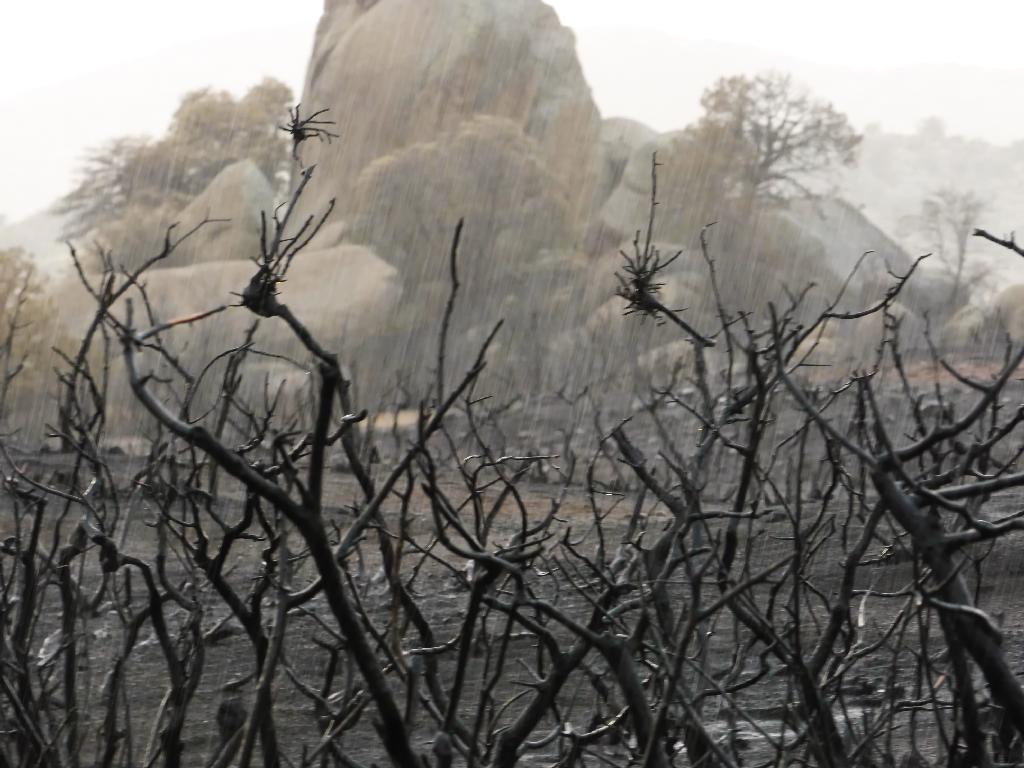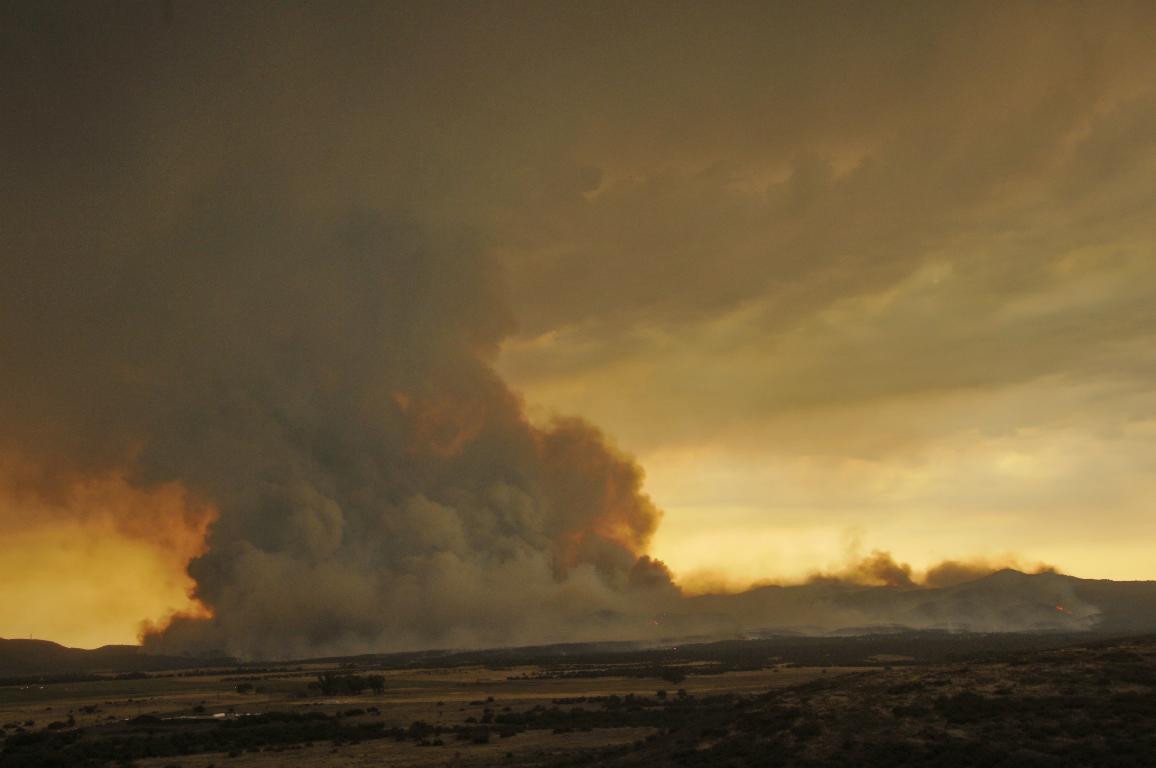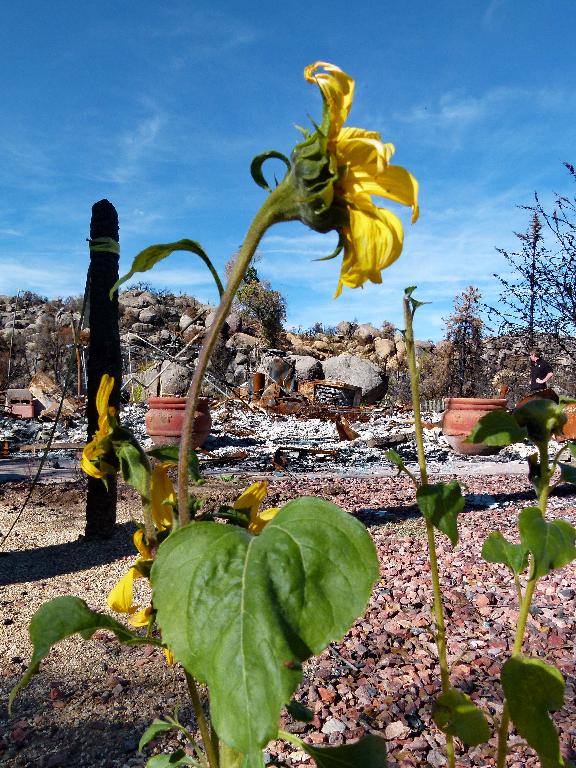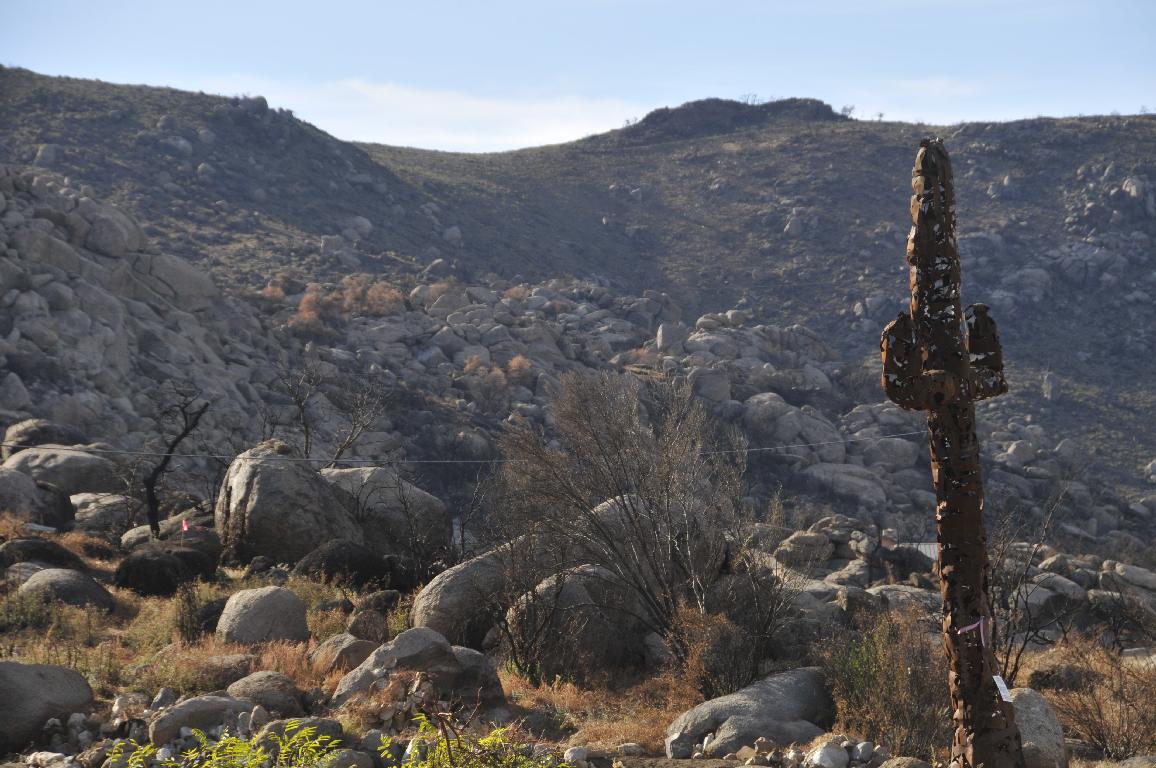Nine months after the tragic Yarnell Hill Fire on June 30, 2013, the event continues to touch many of us with a rawness only slightly softened by time. My memories remain vivid. With thunderstorm activity developing in the Prescott area that afternoon, I grabbed my camera and headed out to the Doce Fire area south of Granite Mountain. Fierce little rain squalls gave me subjects to explore visually. The powdered ash deposits post-fire are very vulnerable to erosion, a step in the ecologic process I wanted to capture.
Then as a squall shifted south, I could see in the distance a column of smoke that caused my hair to rise—it appeared to me that the small town of Yarnell was on fire. Without hesitation, I leaped into the car and shot toward Skull Valley, having to slow down once in the midst of an intense downpour. The closer I got to Peeple’s Valley, the more my concern intensified, and I made a decision that gave me a perfect vantage point on a ridge north of the fire. If I had continued any farther down the highway, I would have been stopped by emergency vehicles and stuck in a line of other cars prohibited from moving farther.
I remember as keenly as if it were still happening how, as I began to photograph the towering cloud of smoke, winds shifted, chilling me briefly with horizontal pellets of rain. A small herd of horses ran north to below my position. I continued to watch and document as the fire split into two fiery tongues—one right at Yarnell and another in rugged canyons in the Weavers to the west of the valley. Planes and helicopters appeared as tiny insects buzzing around the periphery of the towering giant. I watched until sunset, an eerie yellowish light bathing the entire scene, and I sensed that this would be a moment of tragic history.
In early November, I brought my Prescott College class in Interpreting Nature through Art & Photography on an official field trip to Yarnell. Chuck Tidey, Chair of the Yarnell Hill Recovery Group, took us around to see the aftermath of the fire and the rebuilding efforts of local residents. It was sobering to see some of the destroyed homes but uplifting to see the spirited efforts to rebuild. “Yarnell Rising” on Chuck’s shirt and signs in town showed that residents were getting back on their feet. One woman proudly showed me the “miracle rose” that had arisen from the ashes of her burned residence. We all noticed wildflowers rising from the debris, plus oaks and other shrubs sprouting with vigor. Woodpeckers tapped at many of the dead trees, their food supply increased by the fire. Mother Nature needed no humanitarian efforts to get back on her feet, and the rebirth of the chaparral was happening before our very eyes.
What perhaps impressed me most was the fickle nature of the fire. The logic of an advancing fire front just didn’t seem to make sense. Some houses, obvious fire traps, stood untouched amidst dense chaparral, while other houses in the middle of cleared lots were incinerated to the ground. Vibrant living trees unscathed by fire or heat flanked piles of residence rubble. Two adjacent houses—one obliterated, the other immaculate. What kind of weird fire was this?
Recently I was visited by Tom Dolan of Rocklin, California. A dedicated storm chaser, he was drawn to this disaster site by the immensity of the human losses, and he has the computer and meteorological skills to reconstruct such events to help complete the story. His video here is something well worth watching: http://www.youtube.com/watch?v=IP_2wWqTisU.
Tom had discovered my blog entries on the Yarnell fire, and he was intrigued by the perspective from the north. We spent hours viewing his work and mine, and now I feel I have a much deeper understanding and appreciation of the events that happened that day.
The fire has started two days before, but it had remained small and seemingly insignificant. On the morning of June 30, the Granite Mountain Hotshot (GMH) crew was performing routine fireline construction well south of the active front of the fire, which appeared pretty innocuous. Forecast was for another hot, dry day, with slight chances for thundershowers in the afternoon. Business as usual for the crew.
In mid-afternoon, fire activity picked up, but the advancing flames were moving northeast toward Peeple’s Valley, well away from the GMH firefighters. Apparently the crew decided to move down toward a ranch that was fire-wise, a safe harbor if they should get there—but they didn’t.
There has been a lot of speculation about the move that left the firefighters exposed, but with the radar and other records that Dolan has mined, one thing stands out as contributory: extreme weather. I don’t mean the unusual heat of the day or the low fuel content of the tinder-dry chaparral; these things were not extraordinary for this time of year. Instead, the very line of thunderstorms that I had followed down from the Granite Mountain area was moving into a tragic intersection with the fire. Cumulonimbus clouds interacted with the rising smoke column, fanned by winds pushed by the advancing squalls, to create a gigantic pyrocumulonimbus cloud that arose over 40,000 feet in the air. As this happened, winds shifted suddenly, turning away from Peeple’s Valley and heading southeast, then turning fatefully to the south.
Moreover, that now-towering column of smoke, burning debris, and ash interacted with the thunderstorm, and lightning began to flash, a stern warning to anyone near. At least two tornadoes developed, one spinning cyclonically, while at its eastern flank, a companion swirled anticyclonically. This was all captured on film from the south side of the fire by photographer Matt Oss.
It is impossible to know exactly what was occurring in the midst of these two interacting tornadoes, but the rotation in the center must have been extreme. Rains of fiery debris must have fallen from the sky to leave the seemingly random areas of burn/unburn in Yarnell. When the fire suddenly morphed into its gargantuan size, residents barely had time to evacuate; fortunately, all made it out safely, but homes were picked off in that peculiar patchy pattern that defies standard logic. The swirling tornadic winds swept over the hotshot crew, subjecting them to an incredible 2000-degree heat that no shelters could possibly handle. The effect was very similar to what sometimes occurs in volcanic eruptions—a tremendous collapse of the pyrocumulus cloud with rapid horizontal spreading of a super-heated ash flow.
The fire perimeter grew that day from a mere 300 acres, a trifling thing, to more than 8000 acres, with great loss of life and property. Then, in the darkest hour, the interacting storm moved off, and smoke spread out laterally, like fog along the ridges. Houses still burned in Yarnell, but the fighting spirit of the fire was gone, dissipated in its tremendous crash and the dissolution of the tornadoes.
The Granite Mountain Hotshot crew respected fire, but no one could have been prepared for the bizarre interaction of fire and thunderstorm, the creation of a whirling dervish of tornadic energy. Like the devastation of the dragon Smaug on Laketown, the people of Yarnell were hit by forces beyond their control or even comprehension.
The odds of a repeat of this catastrophe may seem small, but chaparral will arise, and it will again burn. The brush had not felt the inevitable flames since 1966, but chaparral thrives with fire; it is on a recovery trajectory that will again leave the area vulnerable in a decade or so. The quaint back streets of Yarnell, where houses are being replaced, are not designed for ready fire truck access or for evacuation. Charm of a rural lifestyle in rocky terrain will be trumped by the reality of vulnerability. And if, under conditions of a warming, drying climate, storms again advance on the town during the hot pre-monsoon, the dragon Smaug might again wreak havoc on the citizens below.
There are many lessons to be learned from the Yarnell Hill Fire, but communities have very short memories. The hills of LA and Oakland have their disaster stories, but things have returned to “normal” in most neighborhoods, as they have in New Orleans, where hurricanes will someday revisit with no respect for the determination of people to rebuild. The same is true across the world in places with histories of intense volcanism, earthquakes, floods, tsunamis, tornadoes.
There are really two major logical alternatives: live with potential calamity and accept the risks, or avoid areas most vulnerable to natural phenomena of great power and potential harm. A third option is, of course, to understand the workings of nature and reduce the risks through careful land management. The forests around Prescott could be returned to some semblance of prehistoric savannahs, where fuel loads were low and fire-return intervals short, but it gets more and more difficult as houses are built within the forests, hindering any thought of controlled fires. Nor do city dwellers appreciate the dramatic reduction in tree density (or the smoke-filled air) that fire management might necessitate.
Fire management in Yarnell is even trickier, as the “natural” state of the chaparral is to grow for some decades, then go up in blazing glory all at once, setting the stage for plant succession to repeat the process. But the Yarnell community is small; Prescott’s growing population creates management challenges on an entirely different scale.
We educated primates are guilty of congenital hubris, I’m afraid. It’s hard for us to see the big picture, to see through time and space, and to learn the lessons that nature provides on an episodic basis. On human scale, disasters seem rare—improbable—but on longer time scales, they are all but inevitable. We also overestimate our abilities to control or manage nature. Nevertheless, we can, as Tom Dolan advises, “Plan, prepare, respond, and recover.” This may mean cost-effective fuel breaks, zoning, and land clearing that may give firefighters a good chance to make a stand if the fire comes. Homes can be rebuilt or constructed elsewhere, but each human life is irreplaceable.
It would be foolish of us to think that Yarnell is unique. In its geography, fuel loads, and distribution of habitation, Prescott currently sits on a powder keg. Short memories and complacency are the enemies of preparedness. It’s essential to stop pointing fingers and second-guessing history; the time to be proactive is now.
Related essays:
Yarnell Fire http://www.geolobo.com/?p=453
Heroes: Reflections on the Granite Mountain Hotshots http://www.geolobo.com/?p=462
Landscape Lunacy: Chaparral on Fire http://www.geolobo.com/?p=464
Granite Mountain Ablaze http://www.geolobo.com/?p=414
Burning Desires and Incendiary Thoughts http://www.geolobo.com/?p=401
This essay was re-published on 26 March 2014 in New Clear Vision as A Naturalist’s Reflections on the Yarnell Fire, http://www.newclearvision.com/2014/03/24/tragic-history/





Thanks Walt. This is a much needed reflection for our healing community.
You are most welcome, Lani.
Wow.
I’ve read all of your posts on these fires Walt and am deeply impressed and moved.
I also appreciate your references to Lord of the Rings, which is always in the back of my mind as a microcosm of forces that we face almost daily.
Rock on, my precious.
Nita
What you describe is a true fire tornado and true firestorm, not unlike the Carr Fire Tornado. It was a pyro-cumulonimbus cloud you report and photograph. The dry lightning was off that fire tornado.
Yes, James. Exactly right!